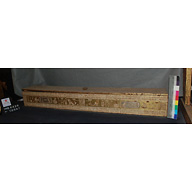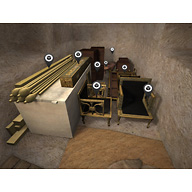-
- Format
- Journal Article
-
- Language
- ENGLISH
-
- Year Published
- 2017
-
- Number of Pages
- 46
-
- Citation Text
-
Manuelian, Peter Der. "The Lost Throne of Queen Hetepheres from Giza: An Archaeological Experiment in Visualization and Fabrication. Journal of the American Research Center in Egypt 53 (2017), pp. 1-46.
-
- Individual - Ancient
- Hetepheres I (G 7000 X)
- Khufu
- Snefru
-
- Individual - Modern
- Ahmed Yusef Mustapha (Effendi)
- Alan Jenvey Rowe, British, 1890–1968
- Bernard Rice
- Campbell Cowan Edgar, British, 1870–1938
- Cecil Mallaby Firth, British, 1878–1931
- Ernest Budge, British, 1857–1934
- Henry Reginald Holland Hall, British, 1873–1930
- James Edward Quibell, British, 1867–1935
- Joseph Gerte, American
- Joseph Lindon Smith, American, 1863–1950
- Lord Edmund Allenby
- Marion Thompson
- Pierre Lucien Lacau, French, 1873–1963
- Said Ahmed Said [Diraz] (Reis)
- Thomas Richard Duncan Greenlees, British, 1899–
- W. A. Stewart
- William Stevenson Smith, American, 1907–1969
-
- Photographer
- Mohammedani Ibrahim
-
- Excavator
- Dows Dunham, American, 1890–1984
- George Andrew Reisner, American, 1867–1942
- Noel F. Wheeler, British
-
- Author
- Peter Der Manuelian, 1959–
-
- Publisher
- American Research Center in Egypt
-
- Site Name Eastern Cemetery
-
- Site Name Other Region
-
Arm chair "B" of Hetepheres I (reproduction)
- HSM_2015.2.1
-
Arm chair of Hetepheres I (reproduction)
- MFAB_38.957
-
Armchair of Queen Hetepheres I
- GEM_6365
-
Bed canopy of Queen Hetepheres I
- GEM_6372
-
Bed of Hetepheres I (reproduction)
- MFAB_29.1858
-
- GEM_6364
-
Bracelet box of Queen Hetepheres I
- GEM_6424
-
Canopy of Hetepheres I (reproduction)
- MFAB_38.873
-
Carrying chair of Queen Hetepheres I
- GEM_6362
-
Curtain box of Hetepheres I (reproduction)
- MFAB_39.746
-
Curtain box of Queen Hetepheres I
- GEM_6426
-
- GEM_6178
-
Headrest of Hetepheres I (reproduction)
- MFAB_29.1859
-
Special Register Vol. 7.16, p.075
- ID: EMC_SR7.16_sp075LR
Ancient People
-
- Type Individual - Ancient
- Remarks Wife of King Snefru, founder of Egypt’s Fourth Dynasty, and mother of King Khufu, builder of the Great Pyramid. Her burial was hidden in a secret chamber (labeled G 7000 X) nearly 90 feet underground, and contained beautiful pieces of gilded and inlaid wooden furniture, silver jewelry, and a large alabaster sarcophagus that was found to be mysteriously empty.
-
- Type Individual - Ancient
- Remarks Second king of Dynasty 4, son of Snefru. Builder of the Great Pyramid at Giza, the only one of the Seven Wonders of the Ancient World still standing. Known two thousand years later by the Greeks as King Cheops. Horus name: [mDdw] Medjedu. Full birth-name: Khnum-Khufu.
-
- Type Individual - Ancient
- Remarks First king of Dynasty 4. Father of Khufu.
Modern People
-
Ahmed Yusef Mustapha (Effendi)
- Type Individual - Modern
- Nationality & Dates
- Remarks Chief restorer of the Egyptian Department of Antiquities at the Cairo Museum. Restorer of Hetepheres' furniture and Khufu's boat.
-
- Type Individual - Modern
- Nationality & Dates British, 1890–1968
- Remarks Egyptologist and archaeologist. Nationality and life dates from Who was Who in Egyptology.
-
- Type Individual - Modern
- Nationality & Dates
- Remarks A primary participant in the reconstruction of the Hetepheres I bed canopy from G 7000 X. cf. Reisner, George A. "The Bed Canopy of the Mother of Cheops." Bulletin of the Museum of Fine Arts, Boston 30, no. 180 (August 1932), p. 57.
-
- Type Individual - Modern
- Nationality & Dates British, 1870–1938
- Remarks Egyptologist and Greek scholar; Acting Director General of the Department of Antiquities. Nationality and life dates from Who was Who in Egyptology.
-
- Type Individual - Modern
- Nationality & Dates British, 1878–1931
- Remarks Egyptologist; husband of Winifred Nest Firth. Nationality and life dates from Who was Who in Egyptology.
-
- Type Excavator
- Nationality & Dates American, 1890–1984
- Remarks Egyptologist; Curator; Assistant Curator, Egyptian Department, Museum of Fine Arts, Boston. Nationality and life dates from Who was Who in Egyptology.
-
- Type Individual - Modern
- Nationality & Dates British, 1857–1934
- Remarks Sir; Egyptologist and orientalist; British Museum curator. Nationality and life dates from Who was Who in Egyptology.
-
- Type Excavator
- Nationality & Dates American, 1867–1942
- Remarks Egyptologist, archaeologist; Referred to as "the doctor" and "mudir" (Arabic for "director") in the excavation records. Nationality and life dates from Who was Who in Egyptology.
-
- Type Individual - Modern
- Nationality & Dates British, 1873–1930
- Remarks British Museum; Egyptologist and historian. Nationality and life dates from Who was Who in Egyptology.
-
- Type Individual - Modern
- Nationality & Dates British, 1867–1935
- Remarks Egyptologist; husband of Annie Abernethie. Nationality and life dates from Who was Who in Egyptology.
-
- Type Individual - Modern
- Nationality & Dates American
-
- Type Individual - Modern
- Nationality & Dates American, 1863–1950
- Remarks Artist /expedition painter and copyist; Daughters Rachael and Frances also painted. Nationality and life dates from Who was Who in Egyptology.
-
- Type Individual - Modern
- Nationality & Dates
- Remarks British High Commissioner of Egypt, 1919-1925.
-
- Type Individual - Modern
- Nationality & Dates
- Remarks Mother of Margaret Dunham (1353)
-
- Type Photographer
- Nationality & Dates
- Remarks Expedition photographer.
-
- Type Excavator
- Nationality & Dates British
- Remarks Wheeler was a Lieutenant Commander in the Royal Navy according to George A. Reisner's, "A HIstory of the Giza Necropolis, Vol. I."
-
- Type Author
- Nationality & Dates 1959–
- Remarks Giza Archives Project Director, 2000-2011; Giza Project at Harvard Director, 2011-present.
-
- Type Individual - Modern
- Nationality & Dates French, 1873–1963
- Remarks Egyptologist. Nationality and life dates from Who was Who in Egyptology. (1873-1963) French Egyptologist; born at Brie-Comte-Robert, 25 Nov. 1873, son of Louis Clément L., an architect, and Lucie AdéIe Belin; he at first entered the Ecole Normale intending to take up geology and studied Natural Science at the Sorbonne; he then turned to philosophy taking his degree in this sub- ject 1897, but studying oriental languages simultaneously; he learnt Hebrew and wrote an article on a text in this language in the Revue d'Assyriologie when he was only twenty-one; the influence of Maspero (q.v.) led him to study Coptic and Egyptian and he joined the lnstitut Français at his suggestion and began work for the Cairo general catalogue; he arrived in Egypt in 1899 and in 1901 published his first article on an Egyptian subject, Textes de I'Ancien Testament en copte sahidique, in the Rec Trav, his first volume for the Catalogue on the coffins in the museum in Cairo followed in1906;in this work he not only revealed his philological knowledge in transcribing the texts, but also noted most carefully all the constructional details and provided useful diagrams as illustration; this work led him to become interested in religious texts and he published a series of articles on the Coffin Texts in Rec Trav, 26-37, which was of great importance before the appearance of the comprehensive work of de Buck (q.v.); he also wrote a number of articles on Egyptian grammar at this period; in 1912 Lacau was appointed Director of the IFAO in Cairo and the following year was elected a member of the lnstitut Egyptien; on 7 Oct. 1914 he was appointed Director of the Antiquities Service but delayed his departure to Egypt for war service until sept. 1915 when he was sent back to Egypt so that he could arrange a proper administration for the Antiquities Service throughout the war period; this done he returned to France, 1916, after delegating his work to the Secretary-General G. Daressy (q.v.); he returned to Egypt in 1917 and resumed his duties; in 1919 he married Anne-Marie Bernard, daughter of the Geography Professor at the Sorbonne, and was made Director of the Institut Français; he was made a correspondant of the Acad. des Inscriptions et Belles-Lettres, 1923; in the period after the war Lacau issued directives for the partial uncovering of the funerary temples and their dependant buildings at Saqqara, and for the study of the Memphite tombs both architecturally and functionally, and for essential restoration and consolidation work to be carried out at Karnak; sondages were also to be made with a view to making possible the publication of all the completed parts; at the time of the discovery of the Tomb of Tutankhamun Lacau insisted on all the finds being retained in Egypt and secured the entire collection for Cairo Museum; he returned to France in 1936, and succeeded Moret (q.v.) in his chair in Paris 1938; in 1939 he became a Member of the Acad. des Inscriptions et Belles- Lettres; after the war he paid three further visits to Egypt, 1950-4, and died in Paris, 27 March 1963; his principal works were, Sarcophages antérieurs au Nouvel Empire, 2 vols. 1904- 6; Fragments d'apocryphes coptes, 1904; Textes coptes en dialectes akhmimique et sahidique, 1908; Textes religieux égyptiens, I pt. 1910; Stéles du Nauvel Empire, 2 vols. 1909,1926, for Cairo Cat.; Une stéle juridique de Karnak, 1949-, Sur le systéme hiéroglyphique, 1954; Une chapelle, de Sésostris ler à Karnak, with H. Chevrier, 1956; La Pyramide ? degrés, tom. 4. Inscriptions gravées sur les vases, with J. P. Lauer, 2 pts., 1959, 1961; Une chapelle d'Hatshebsout à Kamak, with H. Chevrier, 2nds, 1977, 1979. ASAE 59 (1966), 33-52 (portr.) (J. P. Lauer); Annuaire du Collége de France 63 (1963), 39- 41 (M. Bataillon); AfO 21 (1966), 272-3 (J. Leclant); BIFA062 (1964), 231-5 (F. Daumas); Chron. D' Eg. 38 (1966), 244-6 (B. van de Walle); CRAIBL1963, 1964, 105-11 (P. Montet); Rev. Arch. 1963, ii, 55-8 (Ch. Picard); Rev. d'Eg. 15 (1963), 7-10 (portr.) (J. Sainte Fare Garnot); Rev. del'Histoire des Religions, cxliv, no. 444 (1963),128-31 (J. Sainte Fare Garnot).
-
Said Ahmed Said [Diraz] (Reis)
- Type Individual - Modern
- Nationality & Dates
- Remarks Head Reis for the Harvard-MFA expedition, 1908–1926. In his "A History of the Giza Necropolis I," George A Reisner described Said Ahmed Said as "the most gifted foreman who ever worked for the expedition." Father of Mohammed Said Ahmed [Diraz] (Head Reis 1936–1939), Mahmud Said Ahmed [Diraz] (Translator), Ahmed Said Ahmed [Diraz]. Family name, Diraz, was supplied by Said Ahmed Said's grandsons in 2006.
-
Thomas Richard Duncan Greenlees
- Type Individual - Modern
- Nationality & Dates British, 1899–
- Remarks Thomas Richard Duncan Greenlees, born South Africa, Sivaratri, March 10, 1899. British subject with a Scottish father and an English mother. For a brief period during 1925 he was a staff member of Harvard University--Boston Museum of Fine Arts Expedition, who later joined the Theosophist movement in India. Greenlees received his MA degree in 1922 from Oxford, where he studied Egyptian, Coptic and Arabic. April 2,1925, Greenlees appointed Assistant Curator of Egyptian Art at MFA.
-
- Type Individual - Modern
- Nationality & Dates
- Remarks Conservator who assisted with objects from G 7000 X, Hetepheres, at Harvard Camp, Giza.
-
- Type Individual - Modern
- Nationality & Dates American, 1907–1969
- Remarks Egyptologist; Curator, Museum of Fine Arts, Boston. Nationality and life dates from Who was Who in Egyptology.
-
American Research Center in Egypt
- Type Publisher
Name of this image
Description of the image duis mollis, est non commodo luctus, nisi erat porttitor ligula, eget lacinia odio sem nec elit. Sed posuere consectetur est at lobortis. Donec sed odio dui.

- Heather ONeill heather@pixelsforhumans.com
- Nicholas Picardo npicardo@fas.harvard.edu
- Luke Hollis luke@archimedes.digital




